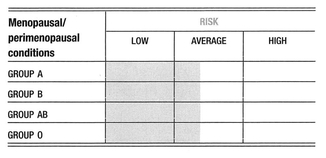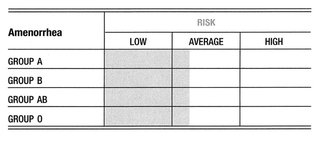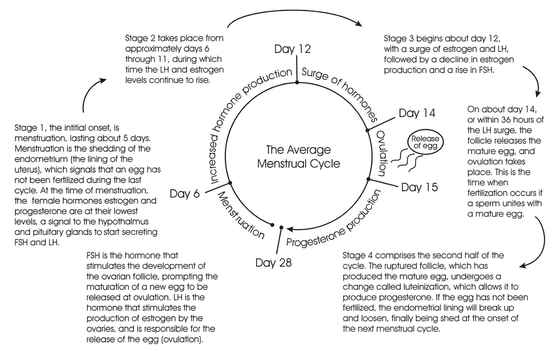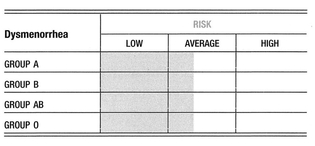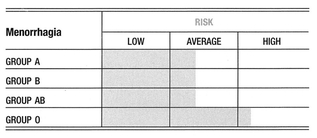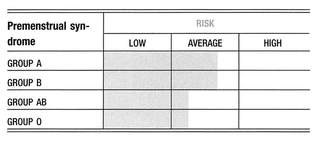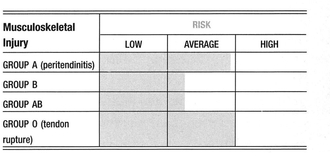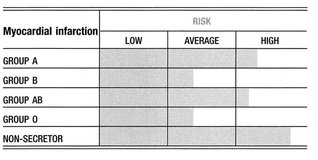M
MALIGNANCY—See Cancer (general)
MANIC DEPRESSIVE DISORDER—See Depression, bipolar
MELANOMA—See Cancer, melanoma
MENINGITIS—See Bacterial disease, meningitis
MENOPAUSAL/PERIMENOPAUSAL CONDITIONS—Conditions associated with hormonal changes accompanying perimenopause and menopause.
Symptoms
The symptoms and degree of symptoms vary greatly among menopausal and perimenopausal women. Except for the cessation of menses, some women are relatively free of symptoms, while others suffer a variety of complaints, including:
• Hot flashes
• Insomnia
• Vaginal dryness
• Urinary leakage
• Dry skin
• Mood swings
• Weight gain
About Menopause
Menopause is a process that takes place over a period of years—typically, between the ages of 47 and 55, although the exact time frame varies for each individual. This time frame is referred to as perimenopause, meaning, literally, “around menopause.”
Although the decline in female hormones is normal, marking the passage from childbearing years, it can also increase the risk of certain conditions. For example, OSTEOPOROSIS, a thinning of the bones that eventually leads to frailty and even death, is a negative result of estrogen deficiency.
The symptoms and degree of symptoms vary greatly among menopausal and perimenopausal women. Except for the cessation of menses, some women are relatively free of symptoms, while others suffer a variety of complaints.
Blood Group Links
Although no studies specifically link blood groups and menopausal conditions, blood groups A and AB have a high susceptibility for BREAST CANCER, making them poor candidates for traditional hormone replacement therapy because elevated levels of estrogen are also associated with breast cancer.
Therapies, Menopausal/Perimenopausal Conditions
ALL BLOOD GROUPS:
An effective alternative to conventional hormone replacement therapy may be the newly available phytoestrogens, which are estrogen-like and progesterone-like preparations derived from plants, principally soybeans, alfalfa, and yams. Many of these preparations are available as a cream that can be applied to the skin several times a day. Plant phytoestrogens are typically high in the estrogen fraction called estriol, whereas chemical estrogens are based on estradiol. The medical literature conclusively shows that supplementation with estriol inhibits the occurrence of breast cancer. Phytoestrogens lack the potency of the chemical estrogens, but they are definitely effective against many of the troubling symptoms of menopause, including hot flashes and vaginal dryness. Because they are only weak estrogens, they will not suppress any estrogen production by the body, unlike the chemical estrogen. It is interesting that in Japan, where the typical diet is high in phytoestrogens, there is no concise Japanese word for menopause. Undoubtedly the widespread use of soy products, which contain the phytoestrogens genistein and daidzein, serves to modulate the severe symptoms of menopause.
Additional ways to relieve menopausal symptoms include the following:
1. Wear layered clothing so that you can remove items if you feel overheated during the day.
2. Avoid caffeine and alcohol; they can trigger hot flashes in some women.
3. Take tepid showers to help bring down a heightened body temperature.
4. Use a lubricating cream such as K-Y Jelly, Replens, or Astroglide for vaginal dryness or itching. Nonabsorbable or minimally absorbable estrogen cream can add lubrication to the vagina without systemic effect.
BLOOD GROUP A:
1. Menopause Support Protocol
2. Female Balancing Protocol
3. Metabolic Enhancement Protocol
BLOOD GROUP B:
1. Menopause Support Protocol
2. Female Balancing Protocol
3. Metabolic Enhancement Protocol
BLOOD GROUP AB:
1. Menopause Support Protocol
2. Female Balancing Protocol
3. Metabolic Enhancement Protocol
BLOOD GROUP O:
1. Menopause Support Protocol
2. Female Balancing Protocol
3. Metabolic Enhancement Protocol
Related Topics
Cancer, breast
Immunity
Osteoporosis
MENORRHAGIA—See Menstrual cycle disorders, menorrhagia
MENSTRUAL CYCLE DISORDERS, AMENORRHEA—Failure to menstruate.
Symptoms
• Failure to begin menstruating by age 14
• Lack of maturation (development of breast and pubic hair) at puberty
• Absence of menstruation for a period of 6 months prior to perimenopause
About the Menstrual Cycle
The average menstrual cycle lasts approximately 28 days, and can be divided into four stages.
Stage 1, the initial onset, is menstruation, lasting about 5 days. Menstruation is the shedding of the endometrium (the lining of the uterus), which signals that an egg has not been fertilized during the last cycle. At the time of menstruation, the female hormones estrogen and progesterone are at their lowest levels, a signal to the hypothalamus and pituitary glands to start secreting follicle-stimulating hormone (FSH) and luteinizing hormone (LH). FSH is the hormone that stimulates the development of the ovarian follicle, prompting the maturation of a new egg to be released at ovulation. LH is the hormone that stimulates the production of estrogen by the ovaries, and is responsible for the release of the egg (ovulation).
Stage 2 takes place from approximately days 6 through 11, during which time the LH and estrogen levels continue to rise.
Stage 3 begins about day 12, with a surge of estrogen and LH, followed by a decline in estrogen production and a rise in FSH. On about day 14, or within 36 hours of the LH surge, the follicle releases the mature egg and ovulation takes place. This is the time when fertilization occurs if a sperm unites with a mature egg.
Stage 4 comprises the second half of the cycle. The ruptured follicle, which has produced the mature egg, undergoes a change called luteinization, which allows it to produce progesterone. Progesterone is the hormone that prepares the uterine lining for pregnancy. During this stage of the cycle, LH and FSH levels drop, while progesterone continues to rise, thickening the outer layer of the endometrium in preparation for pregnancy. If the egg has not been fertilized, the endometrial lining will break up and loosen, finally being shed at the onset of the next menstrual cycle.
About Amenorrhea
Primary amenorrhea is defined as the failure to menstruate by age 14, and the absence of secondary characteristics, like breast and hair development. Even when breast and pubic hair have developed, it refers to the failure to menstruate by age 16. Menstrual patterns run in families; if a mother got her period late, her daughter may have the same experience.
In addition to pregnancy and MENOPAUSE, which should always be ruled out, other causes of amenorrhea are normal. For instance, following childbirth, menstruation may not begin again for several months. Some women fail to regain normal menses after stopping oral contraceptives, but most return to normal within 6 months.
STRESS can affect menstruation. Overwork, personal crises, poor sleep, and poor eating habits may all contribute to a missed period.
Amenorrhea can also be a sign of an endocrine system disorder such as an adrenal disorder, DIABETES, or HYPOTHYROIDISM.
Psychotropic drugs, anticonvulsants, chemotherapy, and anti-estrogens like tamoxifen can also interfere with menstruation.
Amenorrhea accompanied by hirsutism (excess facial and body hair, and sometimes acne and oily skin) implies a possible adrenal disorder causing an excess of male hormones.
Blood Group Links
The age at menarche in relation to ABO blood group phenotypes and hemoglobin-E genotypes have been studied among 290 girls belonging to Mongol ethnic stock in the northeastern region of India. The study shows that the age at menarche is influenced by the abnormal hemoglobin-E genotype as well as ABO blood group phenotype. The genetic markers play a pivotal role in the growth and development of an individual‘.
Therapies, Amenorrhea
BLOOD GROUP A:
1. Female Balancing Protocol
BLOOD GROUP B:
1. Female Balancing Protocol
BLOOD GROUP AB:
1. Female Balancing Protocol
BLOOD GROUP O:
1. Female Balancing Protocol
Related Topics
Anxiety disorders
Growth and maturity
Stress
Thyroid disease, hypothyroidism
REFERENCES
1. Balgir RS. Menarcheal age in relation to ABO blood group phenotypes and haemoglobin-E genotypes. J Assoc Physicians India. 1993;41:210-211.
MENSTRUAL CYCLE DISORDERS, DYSMENORRHEA—Painful menstruation.
Symptoms
The discomfort begins prior to the period, or with the onset of bleeding, and usually subsides within 2 to 3 days after bleeding begins. Symptoms include:
• Low abdominal pain
• Cramping, pulling, or constrictive pangs
• Pain radiating into the back and down the legs
• Clots in menstrual blood
• Premenstrual syndrome (PMS)
About Dysmenorrhea
Dysmenorrhea can be primary (functional) or secondary (acquired). Primary dysmenorrhea occurs during ovulatory cycles, without any identified disorder in the genital tract. Very often, a woman’s liver may be hypofunctioning; she is constipated (estrogens can be reabsorbed from the bowel if the stools are not evacuated frequently enough); and she is hormonally imbalanced, with too high an estrogen level in relation to her progesterone levels.
Secondary dysmenorrhea indicates painful periods due to an identifiable cause such as endometriosis, UTERINE FIBROIDS, pelvic inflammatory disease, or inflammation from an intrauterine contraceptive device (IUD). The majority of dysmenorrhea sufferers also have PMS, and the two syndromes often merge in a welter of signs and symptoms.
Blood Group Links
Although no studies have been performed linking ABO blood groups with dysmenorrhea, many of the potential underlying conditions, such as endometriosis and uterine fibroids, show a higher incidence in groups A and AB.
Therapies, Dysmenorrhea
BLOOD GROUP A:
1. Female Balancing Protocol
2. Anti-Inflammation Protocol
BLOOD GROUP B:
1. Female Balancing Protocol
2. Anti-Inflammation Protocol
BLOOD GROUP AB:
1. Female Balancing Protocol
2. Anti-Inflammation Protocol
BLOOD GROUP O:
1. Female Balancing Protocol
2. Anti-Inflammation Protocol
Related Topics
Blood clotting disorders
Cancer, gynecological tumors
MENSTRUAL CYCLE DISORDERS, MENORRHAGIA—Heavy menses.
Symptoms
• Excessive bleeding during menses
About Menorrhagia
Menorrhagia falls under a broader category of “abnormal bleeding”—prolonged, excessive, or irregular with regard to time of the cycle. It is important in the diagnosis to determine that bleeding is coming from the vagina and not the urethra or the rectum.
Menorrhagia can result from many causes, which are so varied that they may be treated as separate conditions. Dysfunctional uterine bleeding (DUB) describes abnormal uterine bleeding not associated with tumor, inflammation, or pregnancy. This is commonly caused by unopposed estrogen stimulation from a tumor or disease condition, leading the endometrial tissue to hypertrophy and eventually to sloughing and bleeding.
Causes include HYPOTHYROIDISM, endometrial proliferation, hyperplasia, anovulation (lack of ovulation), polycystic ovaries, ovarian tumor, obesity, endometrial polyps, endometrial neoplasia, and FIBROIDS. Risk factors include OBESITY, anovulation, and hormone replacement therapy without progestin.
Blood Group Links
Oral contraceptives may have a blood-group related effect on blood clotting, which is especially important for blood group O.
A randomized clinical trial of oral contraceptives evaluated 67 women on a regimen of 50 mcg of ethinyl estradiol and 1.0 mg of norethindrone; 61 women on a regimen of 35 mcg of ethinyl estradiol and 1.0 mcg of norethindrone; and 64 women on a regimen of 35 mcg of ethinyl estradiol and 0.5 mg of norethindrone. The ABO blood group was determined for all of the women. An analysis of the interrelationships among antithrombin III (blood clotting factor) by activity method, oral contraceptive type, and ABO blood group showed larger declines in clotting activity for blood group O women using the highest estrogen dose preparation1.
Therapies, Menorrhagia
BLOOD GROUP A:
1. Female Balancing Protocol
2. Blood-Building Protocol
BLOOD GROUP B:
1. Female Balancing Protocol
2. Blood-Building Protocol
BLOOD GROUP AB:
1. Female Balancing Protocol
2. Blood-Building Protocol
BLOOD GROUP O:
1. Female Balancing Protocol
2. Blood-Building Protocol
Related Topics
Blood clotting disorders
Cancer, gynecological tumors
Menopausal/perimenopausal conditions
REFERENCES
1. Burkman RT, Bell WR, Zacur HA, Kimball AW. Oral contraceptives and antithrombin III: variations by dosage and ABO blood group. Am J Obstet Gynecol. 1991;164(1):1453—1458.
MENSTRUAL CYCLE DISORDERS, PREMENSTRUAL SYNDROME (PMS)—A constellation of symptoms that arise in the 7 to 14 days before menses starts.
Symptoms
• Nervousness
• Irritability
• Emotional instability
• Depression
• Headaches
• Edema
• Swollen, achy breasts
• Food cravings
About PMS
Although most women experience minor physical or emotional changes before menstruation, about 10% of women have symptoms severe enough to impede their daily life. More than 150 symptoms are associated with PMS, including tension, irritability, breast tenderness, bloating, and gastric distress.
Severe symptoms of PMS, including DEPRESSION, irritability, and mood swings, are referred to as premenstrual dysphoric disorder. There is a risk for other conditions such as depression. Caffeine and high fluid intake can exacerbate PMS symptoms, and STRESS may precipitate the symptoms. The severity of PMS increases with age.
Blood Group Links
Although no studies directly link premenstrual syndrome with blood groups, many of the common symptoms are more typical of blood groups A and B, especially in highly stressful conditions.
Therapies, Premenstrual Syndrome
BLOOD GROUP A:
1. Female Balancing Protocol
2. Antistress Protocol
3. Fatigue-Fighting Protocol
BLOOD GROUP B:
1. Female Balancing Protocol
2. Antistress Protocol
3. Fatigue-Fighting Protocol
BLOOD GROUP AB:
1. Female Balancing Protocol
2. Antistress Protocol
3. Fatigue-Fighting Protocol
BLOOD GROUP O:
1. Female Balancing Protocol
2. Antistress Protocol
3. Fatigue-Fighting Protocol
Related Topics
Depression, unipolar, bipolar
Digestion
Lectins
Stress
METABOLISM—See Insulin resistance
METASTASIS—See Cancer, general
MIGRAINE—See Headache
MISCARRIAGE—See Infertility
MITRAL VALVE PROLAPSE—See Cardiovascular disease
MONONUCLEOSIS—See Viral disease, mononucleosis
MOUTH SORES—See Fungal disease, candidiasis (oral)
MULTIPLE SCLEROSIS—See Autoimmune disease, multiple sclerosis
MUMPS—See Viral disease, mumps
MUSCULOSKELETAL INJURY—Damage to the muscles or bone.
Symptoms
• Pain
• Swelling
• Stiffness
• Inability to move the affected limb
About Musculoskeletal Injury
The healing of injuries such as sprains, strains, and skin wounds requires the involvement of many body systems, including the circulatory system, the immune system, and the cellular mechanisms. All are needed to repair and grow new tissues.
Blood Group Links
There are differences among the blood groups in susceptibility to common musculoskeletal injuries.
The distribution of the ABO blood groups was studied in 917 patients with specific musculoskeletal diagnoses. The ABO blood group distribution of patients with ruptures of the Achilles tendon, and of patients with chronic Achilles peritendinitis, differed from control individuals. The ABO blood group distribution was not associated with any other musculoskeletal injuries studied. The blood group A to O ratio was 1.42 in the control population. In the group with rupture of the Achilles tendon this ratio was 1.0, and in the group with Achilles peritendinitis it was 0.70. The association between injuries of the Achilles tendon and the ABO blood group distribution was in accordance with an earlier report. There may be a genetic linkage between the ABO blood groups and the molecular structure of the tissue of Achilles tendon1.
In a Hungarian study, 53% of the 873 cases of subcutaneous (spontaneous) tendon ruptures treated by the National Institute of Traumatology belonged to blood group O; that percentage was significantly higher than found in the healthy population (31.1%) of Hungary. The ratio of the tendon rupture patients belonging to blood group A was significantly lower (27.1%) than in the overall population (42.4%). The ratio of the cases belonging to group O among the multiple tendon rupture and re-rupture patients proved to be over 70%. On the basis of this data, the investigators suggested that there is a relation between the ABO blood group system and the tendon rupture. Blood group O individuals are more likely to experience a tendon rupture, whereas blood group A individuals appear to be more protected against tendon rupture2.
Therapies, Musculoskeletal Injury
BLOOD GROUP A:
1. Immune Enhancing Protocol
2. [Women] Menopause Support Protocol
3. Anti-Inflammation Protocol
4. Arthritis Protocol
BLOOD GROUP B:
1. Immune-Enhancing Protocol
2. [Women] Menopause Support Protocol
3. Anti-Inflammation Health Protocol
4. Arthritis Protocol
BLOOD GROUP AB:
1. Immune-Enhancing Protocol
2. [Women] Menopause Support Protocol
3. Anti-Inflammation Protocol
4. Arthritis Protocol
BLOOD GROUP O:
1. Immune-Enhancing Protocol
2. [Women] Menopause Support Protocol
3. Anti-Inflammation Protocol
4. Arthritis Protocol
Related Topics
Arthritis, osteo-
Blood clotting disorders
Inflammation
REFERENCES
1. Kujala UM, Jarvinen M, Natri A, et al. ABO blood groups and musculoskeletal injuries. Injury. 1992;23:131-133.
2. Jozsa L, Barzo M, Balint JB. [Correlations between the ABO blood group system and tendon rupture.] Magy Traumatol Orthop Helyreallito Seb. 1990;33:101-104.
MYASTHENIA GRAVIS—See Autoimmune disease, myasthenia gravis
MYOCARDIAL INFARCTION—Heart attack.
Symptoms
About two-thirds of patients experience symptoms days to weeks before a heart attack, including the following:
• Unstable or crescendo angina
• Shortness of breath
• Fatigue
Symptoms that a heart attack is occurring include the following:
• Deep, substernal, visceral chest pain described as aching or pressure, often with radiation to the back, jaw, or left arm
• Apprehension and a sense of impending doom
• Nausea and vomiting (potentially)
About Heart Attacks
Heart attacks occur when there is severe scarring or death of heart muscle due to lack of oxygen. Oxygen-rich blood is blocked by a blood clot in a coronary artery, usually due to plaque-related narrowing of the artery—this is known as CORONARY ARTERY DISEASE. Heart attacks do not always occur in cases of coronary artery disease, but individuals with arterial blockages are at great risk for heart attacks.
Blood Group Links
Numerous studies have made the connection between blood groups and all forms and signs of HEART DISEASE, including heart attacks.
A study of 255 women published in the Journal of the American Medical Association, originally designed to study the effects of smoking on the rates of heart attack in women, also found several other factors were significantly associated with heart attacks in this group. These factors included HYPERTENSION, ANGINA PECTORIS, family history, DIABETES MELLITUS, and blood group A. The study confirmed numerous other findings that blood group A has a higher risk of heart disease1.
A 1985 study looked at blood groups and heart attacks in two different age groups: those 65 years old and older, and younger patients. The predominance of blood group A in patients with cardiac infarction was deemed “highly significant” in both age groups. This study was unique in that other risk factors, such as smoking, HIGH BLOOD PRESSURE, diabetes, and HIGH CHOLESTEROL levels, were excluded from the study. When the researchers looked specifically at the more elderly population, the predominance of blood group A in the older patients with cardiac infarction was even higher. The researchers concluded that the result “strongly suggests the existence of a genetic factor associated with blood group A, and independent of the other risk factors which are also responsible for a greater incidence of cardiac infarction”2.
Data further allow the conclusion that the ABO non-secretor phenotypes are a risk factor for myocardial infarction. This is particularly true for recessive Lewis blood types and even more so among men than women. ABO secretors seem to have been given a bit of genetic resistance against heart disease, whereas Lewis negative individuals appear to be at the highest risk3.
The relation of total serum alkaline phosphatase and serum cholesterol in convalescing patients of myocardial infarction to the patient’s secretor status and blood group has been studied. Serum cholesterol and alkaline phosphatase levels showed a significant difference in secretors (98) and non-secretors (56) in myocardial groups. The total cholesterol and total serum alkaline phosphatase levels showed a significant difference in secretors when blood groups A and O were compared, with blood group O having much higher levels of serum alkaline phosphatase and much lower levels of cholesterol. In non-secretors, blood group O had higher levels of cholesterol and group A had higher levels of alkaline phosphatase 4,5.
Therapies, Myocardial Infarction
BLOOD GROUP A:
1. Cardiovascular Protocol
2. Metabolic Enhancement Protocol
3. Antistress Protocol
BLOOD GROUP B:
1. Cardiovascular Protocol
2. Metabolic Enhancement Protocol
3. Antistress Protocol
BLOOD GROUP AB:
1. Cardiovascular Protocol
2. Metabolic Enhancement Protocol
3. Antistress Protocol
BLOOD GROUP O:
1. Cardiovascular Protocol
2. Metabolic Enhancement Protocol
3. Antistress Protocol
Related Topics
Angina pectoris
Atherosclerosis
Blood clotting disorders
Diabetes mellitus, type II
Heart attack
Hypercholesterolemin
Hypertension
Obesity
REFERENCES
1. Stolley PD, Shapiro S. Myocardial infarction in women under 50 years of age. JAMA. 1983;250:2801-2806.
2. Platt D, Muhlberg W, Kiehl L, Schmitt-Ruth R. ABO blood group system, age, sex, risk factors and cardiac infarction. Arch Gerontol Geriatr. 1985;4:241-249.
3. Hein HO, Sorensen H, Suadicani P, Gyntelberg F. The Lewis blood group—a new genetic marker of ischaemic heart disease. J Intern Med. 1992;232:481-487.
4. Mehta NJ, Rege DV, Kulkarni MB. Total serum alkaline phosphatase (SAP) and serum cholesterol in relation to secretor status and blood groups in myocardial infarction patients. Indian Heart J. 1989;41:82-85.
5. Bayer PM, Hotschek H, Knoth E. Intestinal alkaline phosphatase and the ABO blood group system—a new aspect. Clin Chim Acta. 1980;108:81-87.
